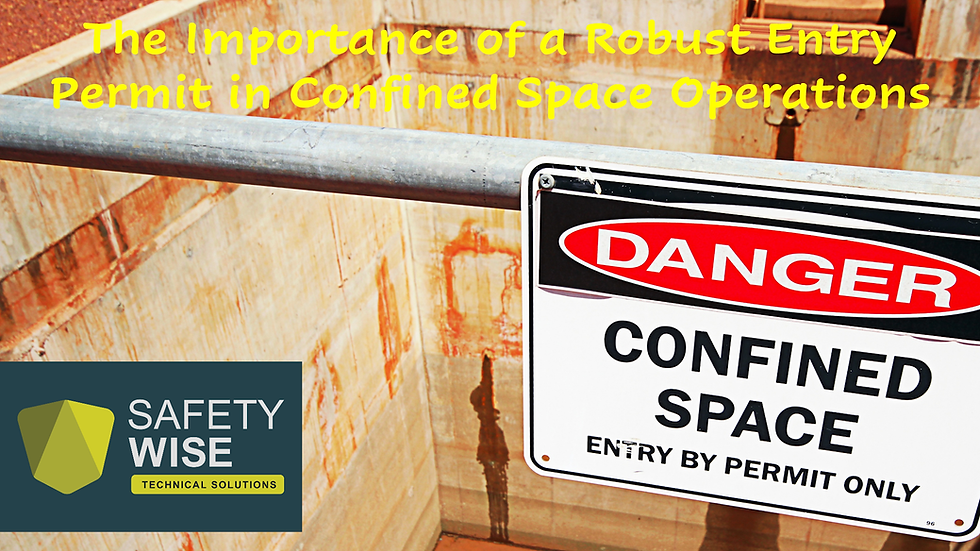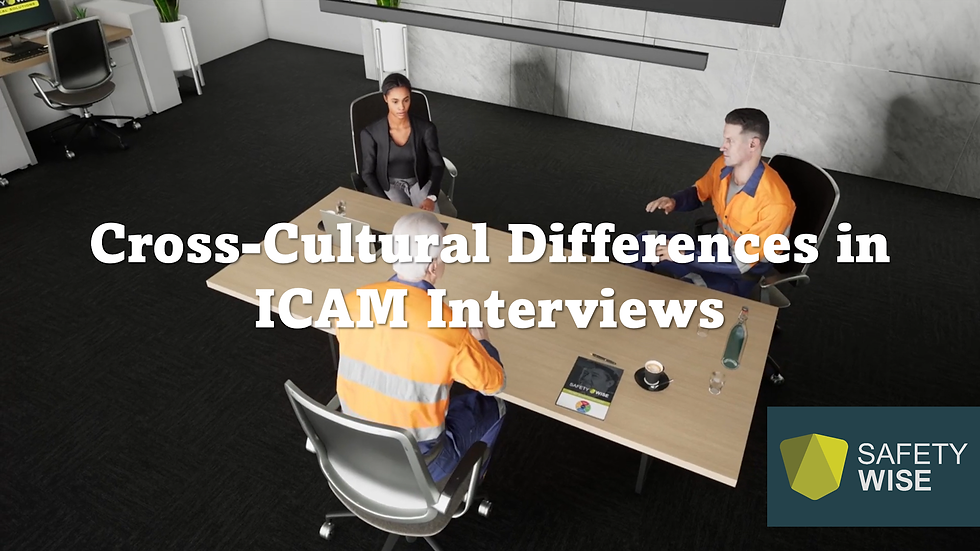The Importance of a Robust Entry Permit in Confined Space Operations
- Luke Dam
- Aug 22
- 6 min read

Introduction
Confined space operations are some of the most hazardous tasks undertaken in industry. They often combine multiple high-risk elements: toxic atmospheres, oxygen deficiency or enrichment, flammable gases or vapours, engulfment hazards, extreme temperatures, noise, restricted mobility, and difficulty in emergency response. Tragically, confined space incidents still result in fatalities every year- and they frequently involve multiple victims when would-be rescuers enter without proper precautions.
One of the most effective administrative controls for preventing these incidents is the confined space entry permit. When implemented properly, the permit-to-work (PTW) system serves as a formal, auditable process for ensuring that hazards are identified, risks are assessed, control measures are in place, and all persons entering the space are aware of the hazards and their roles.
A “robust” entry permit is more than just a piece of paper. It is a living document backed by a safety culture, trained personnel, and clearly defined accountabilities. It should not be treated as a bureaucratic hurdle, but rather as a critical risk management tool that can save lives.
1. Understanding Confined Spaces and Their Hazards
1.1 Defining a Confined Space
While definitions vary by jurisdiction, most agree that in general terms, a confined space:
Is not designed for continuous occupancy;
Has limited or restricted means for entry or exit; and
Is large enough for a person to enter and perform work.
In addition, it often contains, or has the potential to contain, hazardous atmospheres or other dangerous conditions. Examples include tanks, silos, pits, sewers, pipelines, and crawl spaces.
1.2 Common Hazards in Confined Spaces
Confined space hazards can be immediate, invisible, and rapidly lethal:
Atmospheric hazards: Oxygen deficiency (<19.5%) or enrichment (>23.5%), toxic gases (H₂S, CO, ammonia), or flammable vapours.
Engulfment hazards: Grain, sand, liquids that can submerge and suffocate a worker.
Mechanical and energy hazards: Moving parts, stored hydraulic or pneumatic energy.
Temperature extremes: Heat stress, hypothermia.
Poor visibility and mobility: Restricting escape and rescue.
2. The Permit-to-Work System
2.1 Purpose of a Permit-to-Work
A confined space entry permit is a formal written authorisation that:
Confirms all hazards have been identified.
Documents control measures to mitigate those hazards.
Specifies entry conditions and acceptable limits (e.g., oxygen concentration, LEL for flammable gases).
Lists names of authorised entrants, attendants, and supervisors.
Establishes communication and rescue procedures.
In essence, the permit ensures a structured, step-by-step process for safe entry and work in confined spaces.
2.2 Legal and Regulatory Context
In Australia, for example, Work Health and Safety (WHS) Regulations require a written permit for all confined space entries, detailing:
The space to be entered.
The work to be done.
Hazards and risk controls.
Duration of the permit.
Emergency procedures.
Similar requirements exist under OSHA (29 CFR 1910.146) in the United States, the UK’s Confined Spaces Regulations 1997, and other international frameworks.
Failure to comply with these requirements can result in prosecution, heavy fines, and — most tragically — fatalities.
3. Why a “Robust” Permit Matters
A weak, incomplete, or “tick-the-box” permit is worse than no permit at all because it creates a false sense of security. A robust entry permit:
Ensures comprehensive hazard identification- considering not just obvious atmospheric hazards, but also mechanical isolation, stored energy, adjacent processes, and potential environmental changes.
Drives accountability- requiring signatures from supervisors, entrants, and attendants ensures everyone knows their role and responsibilities.
Serves as a communication tool- clearly documenting the scope of work, hazards, and controls for all parties, including contractors.
Supports legal defensibility- a well-documented permit process can demonstrate due diligence if an incident is investigated.
Provides a baseline for auditing and continuous improvement- completed permits can be reviewed to identify recurring issues or weaknesses in risk control.
4. Key Elements of a Robust Confined Space Entry Permit
4.1 Detailed Space Identification
The permit must clearly identify the confined space, its exact location, and any unique features or access points. Ambiguity here can lead to workers entering the wrong space; a surprisingly common cause of incidents.
4.2 Scope of Work
Specify exactly what work will be performed. Cutting, welding, cleaning, painting, and inspection- each has different hazards and control requirements.
4.3 Hazard Identification and Risk Assessment
Include both atmospheric and physical hazards. A risk matrix can help determine control measures and whether entry is justified at all.
4.4 Isolation and Lockout/Tagout (LOTO)
The permit should document all energy sources (electrical, hydraulic, pneumatic, chemical, gravitational) and confirm isolation is in place. This includes blanking off lines, disconnecting power, and verifying zero energy.
4.5 Atmospheric Testing
Pre-entry and monitoring requirements must be documented, including:
Oxygen content.
Flammable gas concentration (%LEL).
Toxic gas concentrations.
Results, calibration dates of instruments, and tester’s name should be recorded.
4.6 Control Measures
These may include:
Forced air ventilation.
PPE (respirators, harnesses, protective clothing).
Intrinsically safe equipment.
Fall protection systems.
4.7 Communication Procedures
Clear protocols for entrant–attendant–supervisor communication (radios, hard-wired intercoms, hand signals).
4.8 Emergency and Rescue Plan
Rescue is often overlooked- a permit must specify rescue team availability, equipment, and method (non-entry retrieval where possible).
4.9 Authorisation and Duration
Define when the permit starts and expires, with signatures from authorising personnel. Expired permits require re-assessment before work resumes.
5. Common Weaknesses in Permit Systems
Even when a permit process exists, several pitfalls undermine its effectiveness:
Copy-paste hazard lists without site-specific assessment.
Lack of training for those issuing or signing permits.
Failure to verify controls before issuing the permit.
Ignoring scope changes- continuing work beyond what the permit covers.
Permits issued remotely without the issuer visiting the site and verifying all controls are in place.
These weaknesses convert the permit into a paper exercise rather than a control measure.
6. Case Studies Demonstrating the Importance of Robust Permits
6.1 Case Study: Double Fatality in a Sewer Manhole (United States)
Two maintenance workers died from hydrogen sulfide exposure. Investigation found the permit listed “ventilation” as a control but did not verify airflow or monitor the atmosphere continuously. Rescue attempts were delayed because no rescue plan was in place.
Lesson: The permit must be specific, enforceable, and backed by actual hazard control, not just listed requirements.
6.2 Case Study: Grain Silo Engulfment (Australia)
A worker entered a silo without isolation of auger equipment. The permit was incomplete and signed off without verifying LOTO. The auger was activated remotely, leading to engulfment.
Lesson: Verification of isolation is critical- a robust permit demands proof before authorisation.
6.3 Case Study: Welding in a Confined Tank (UK)
Hot work generated flammable vapours; inadequate atmospheric testing meant the hazard went undetected until ignition occurred. The permit had expired but work continued.
Lesson: Permit duration, re-testing, and strict adherence to expiry times prevent such incidents.
7. Human Factors in Permit Effectiveness
A robust entry permit must account for human factors:
Complacency: Experienced workers may see permits as red tape.
Production pressure: Supervisors may shortcut procedures to meet deadlines.
Role confusion: Entrants, attendants, and supervisors must understand their distinct duties.
Training gaps: All parties must be competent in hazard recognition, permit issuance, and emergency response.
Embedding a safety culture where the permit is viewed as a lifesaving tool, not an administrative burden, is key.
8. Best Practices for Developing and Maintaining a Robust Permit System
Train all permit issuers, receivers, and entrants in hazard identification and confined space requirements.
Standardise permit forms but allow space for site-specific details.
Involve the work team in hazard assessment to ensure no risks are overlooked.
Require on-site verification by the person issuing the permit.
Link permit issuance to isolation verification and atmospheric test results.
Enforce permit duration and re-validation after breaks, shift changes, or scope changes.
Audit permits regularly and share lessons learned.
Integrate with digital systems where appropriate, enabling real-time updates and recordkeeping.
9. Conclusion
Confined space incidents remain among the deadliest in industry, yet they are preventable with the right controls. A robust confined space entry permit is not a bureaucratic nicety- it is the structured, enforceable process that ensures hazards are understood, risks are controlled, and all parties are prepared for safe entry and work.
When organisations treat the permit as a living safety tool, supported by training, verification, and a strong safety culture, they protect not only compliance but lives. Every box ticked on a well-constructed permit is a step away from tragedy.




Comments